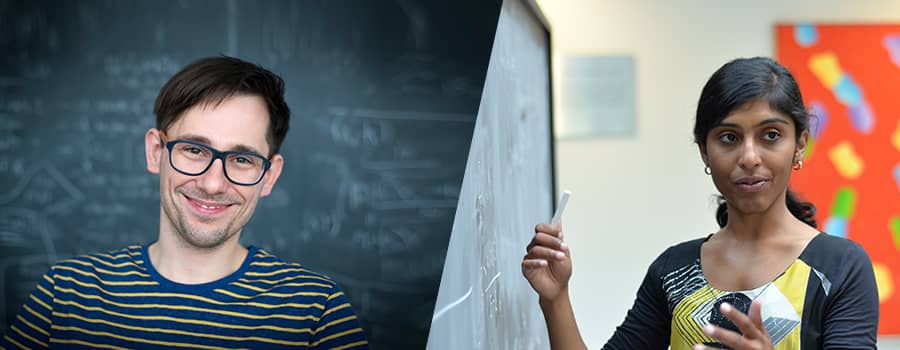Future looks bright for PI postdocs
Two Perimeter postdoctoral fellows will soon head to the United States and Germany to pursue research seeded in Waterloo.
Take a self-guided tour from quantum to cosmos!
Two Perimeter postdoctoral fellows will soon head to the United States and Germany to pursue research seeded in Waterloo.

Two Perimeter postdoctoral fellows have landed coveted positions in Europe and North America, where they will pursue ambitious research agendas in high energy physics and condensed matter.
After winning a prestigious €1.65 million Sofja Kovalevskaja Award from the Alexander von Humboldt Foundation, high energy physicist Michal P. Heller will set up a research group at the Max Planck Institute for Gravitational Physics in Potsdam, Germany, this December.
Condensed matter researcher Anushya Chandran will soon head to Boston University, where she will be a tenure-track Assistant Professor in the physics department.
The positions recognize not just the value of the researchers’ work so far, but the huge potential of the research avenues they now plan to pursue.

They also contribute to Perimeter’s track record for postdoc success: of the 69 people who completed postdoctoral fellowships at PI between 2011 and 2015, 29 went on to positions in academia, 37 gained research positions, and three went into industry.
Heller came to Perimeter specializing in using string theory to describe nuclear physics, and shifted focus during his PI postdoc towards the growing links between high energy physics and quantum information.
“When it comes to PI, the thing I appreciate the most is the openness of people to talk about your own ideas, and the fact there are so many great seminars and so many great people that come and visit. That creates a very stimulating atmosphere,” he says.
Heller previously held a postdoctoral research fellowship in the Netherlands. The boost in citations and profile he received thanks to the fellowship hinted at the impact a much bigger grant could have on his career as an independent researcher.
Now, he’s about to find out. The research group he will lead in Potsdam will probe emerging relationships between quantum information, quantum field theories, and geometry.
“This discipline is not very well represented in Europe because it’s brand new, so I want to be one of the seeds that’s going to start an explosion there,” he says.
The position comes without tenure – but that strikes him as a fair deal. “It’s a lot of money to excel in your research,” says Heller, who is 32. “The price you pay is that you really have to excel to progress to the next step. But you have all the resources available.”
Chandran will also dive into a new area of research when she joins the faculty at Boston University.
Her work at Perimeter focused on two broad areas connecting condensed matter and quantum information: how entanglement encodes different phases of matter, and the study of many-body systems that are out of equilibrium and may never reach equilibrium.
“Nothing that I’ve done is traditionally condensed matter,” says Chandran. “While it starts out with questions motivated by materials or specific experiments, I end up using tools and thinking about things that don’t traditionally show up in material context.”
In Boston, she plans to extend that research into the emerging field of ultra-fast spectroscopic experiments. These experiments take a material, subject it to extremely short pulses – in the order of picoseconds or femtoseconds – then assess the impact on the material.
“They’ve technologically come to the point where they can see real-time quantum dynamics, but in a very complicated material,” says Chandran, 29, who studied electrical engineering in India before doing her physics PhD at Princeton.
“I think there’s an opportunity to take some of the understanding from synthetic matter experiments – where the long time-scales and isolation of the system allow you to really look at quantum mechanics out of equilibrium – and ask if any of that physics is pertinent on the electrons on really short time-scales.”
The new positions also close some personal loops for each of the researchers. Chandran’s husband, physicist Chris Laumann, also accepted a position at Boston University, finally solving their “two-body problem.”
And Heller will head back to Europe with his artist wife Joanna Wróblewska – after they fit in a bit more sightseeing. “I really like Canada,” he said. “It would be great to stay here, but I got something I cannot refuse.”
Still trying to find the perfect present for the physics lover on your list? Our latest gift guide is sure to inspire. It’s science.
‘Magic’ has a technical meaning in quantum theory, and Perimeter’s Timothy Hsieh and collaborators have found a huge source of it.
The International Summer School for Young Physicists is the ultimate summer camp for high schoolers with a passion for science. Though forced to go online-only by the pandemic, the program still succeeded in building connections which the campers say could last a lifetime.